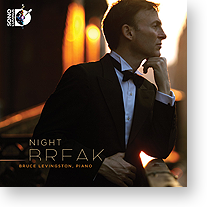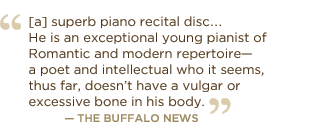

Nightbreak by Bruce Levingston
PREFACE
The idea of titling this CD Nightbreak occurred to me when I realized, quite "unconsciously", that I had assembled and recorded a number of works that vividly display the light and darkness of the human soul. From the dramatic sound-portraits of Franz Liszt's powerful and moving Vallee d'Obermann and Brahms anguished "Edward" Ballade to Philip Glass's brilliant and thrilling "Dracula Suite", these works capture a panoramic range of human feelings and emotions. The shifting shadows of the mind and spirit are also revealed in the poetic nocturnes and waltzes by Liszt, Brahms and Wolfgang Rihm, as well as Liszt's magnificent, impressionistic Les jeux d'eaux a la Villa d'Este, a tour de force of color and chiaroscuro in sound. Heard altogether, this collection reminded me of that moment when day meets night, when the spectrums of the sun and moon mingle together with a mysterious, nuanced and haunting palette, what I call "nightbreak".Franz Liszt
Vallee d'Obermann
Les Cloches de Geneve
Les jeux d'eaux a la Villa d'Este
Vallee d'Obermann, the largest work in Franz Liszt's Swiss Year Of Pilgrimage, was inspired by a reading of Etienne Pivert de Senancour's romantic novel, Obermann (1804). Liszt felt a genuine affinity for the work's central character, Obermann, a conflicted and wandering figure who, like the composer himself, grappled with the meaning of existence. Cries Obermann: "What do I want? What am I? What shall I ask of nature?...all causes are invisible, all ends treacherous, all forms change, all duration vanishes... Employing his signature technique of thematic transformation, Liszt composes a psychological/musical landscape not only of Obermann, but also of himself. Vallee d'Obermann evolves into a highly personal self-portrait revealing the composer's own epic journey of self-doubt, discovery and triumph. Encompassing a panoramic range of emotions and feelings, the work concludes with a spiritual transfiguration of immense joy and optimism. Yet, even in the exultation of the final pages, Liszt closes with a forceful reminder of the valley of darkness from which he has emerged.
Johannes Brahms
Ballade in D minor, Op. 10, No. 1 "Edward"
Intermezzo in E major, Op. 116, No. 4 ("Nocturne")
Waltz in D minor, Op. 39, No. 9
The Ballade in D minor was inspired by the Scottish poem "Edward". A story of patricide, Brahms vividly captures the drama and tragedy of the poetry that inspired this early masterpiece. The original ballad depicts a son's murder of his father at the behest of his mother. Brahms composed the work in 1854, only months after his close friend and musical father Robert Schumann, in a failed suicide attempt, threw himself into the Rhine. Robert and Clara Schumann, among the first major figures in Europe to herald the genius of the then unknown Brahms, welcomed the younger composer into their home and family. It seems more than coincidence that during the period of greatest crisis in Schumann's life, Brahms was drawn to the dark and forbidding text of "Edward". Perhaps setting the work into this musical portrait allowed Brahms a release from his own conflicted feelings over Robert, to whom he was devoted, and, Clara, with whom he certainly was in love. Brahms follows the original form of the text by casting the opening as a dialogue between mother and son. The confession of the murder is actually given over to the central section in the major key with an effect that is eerily both heroic and tragic. The most wrenching part of the music, however, is reserved for the quiet final measures in which a plaintive heartbeat is the only company left a desolate mother and wife for "such counsels ye gave to me, O!"
Brahms late works are notable not only for their deeply personal, autumnal quality but also for the seeds of expressionism they contain that ultimately found fruition in the works of Schoenberg, Berg, and Webern and later in the neo-expressionism of Wolfgang Rihm. The Intermezzo in E in major, from "Fantasies", Opus 116, is subtitled "Nocturne". Here Brahms develops a series of gentle questioning and answering motifs into one his most concentrated and deeply expressive works. Brahms, German by birth, but Viennese at heart, naturally loved waltzes. Though he composed few himself, he greatly admired those of his good friend Johann Strauss Jr. (Brahms famously signed an autograph fan by writing under the opening bars of Strauss' The Blue Danube, "Alas, not by Johannes Brahms"!) Those waltzes that Brahms did write were much more intimate and reserved in character than those of Strauss. The delicate, wistful Waltz in D minor contains many of Brahms' hallmark devices including subtle plays of rhythm and a piquant use of the interval of the second that adds unsuspected depth and color to this tender piece.
Wolfgang Rihm
Brahmsliebewaltzer
Rihm's Brahmsliebewaltzer is a loving homage to his famous fellow countryman, Brahms. Rihm employs Brahms' languorous descending thirds, piquant seconds, and playful rhythmic leger de main to evoke a kind of auditory "memory" of the great master. Bittersweet in tone and quality, the work possesses both a nostalgic and haunting, distorted mirror quality that reflects Rihm's unique, hyper-expressive sensibility and historically attuned voice
Philip Glass
Dracula Suite
Originally composed for string quartet as a soundtrack for a special release of the original 1931 Universal classic, Glass's Dracula Suite encompasses five of the most colorful and dramatic works from the original score. I transcribed the work under the guidance and supervision of Glass himself. In this suite, not only is the formidable and mysterious figure of Dracula himself represented, but also the unforgettable insane Renfield (Glass's repeated use of eerily obsessive trills nicely does the trick!) and, of course, the heroic, relentless Van Helsing. Even the wild, carriage without a driver is given a brilliant rendering. The Dracula Suite vividly captures all the pathos, conflicts and tragic, explosive emotions of its characters, good and bad, light and dark, and all in-between, that express that magical state of nightbreak.
- Notes by Bruce Levingston





